A road-map for imagining a future and the benefits of virtual worlds was laid out at The Serious Virtual Worlds Conference held in Coventry University, England last week.
In the picture above are David Wortley, Director of the Serious Games Institute (holding the user interface for Guitar Hero) and on the right Dr. Timothy W. Foresman pioneer for the global expansion of the Digital Earth vision.
On Day 2 all the speakers presented wearing the Guitar Hero guitar. Perhaps this was a reminder of Babbage Linden’s warning from Day 1 to beware of making false dichotomies between play and work. But with this in mind and wearing the guitar, Dr. Tim Foresman made a serious call to action for a Digital and Virtual Worlds Commons to address the most pressing needs of the 21st Century.
In an interview with Ugotrade Dr. Tim Foresman gave a prediction for Second Life.
Second Life taps into an element called culture. Culture is that which we have evolved to which doesn’t exist in other species which is the creme de la creme for our evolutionary consciousness. Culture is the key here.
This will be the penultimate statement I am going to give you. The Chinese are not ready for us to watch the Olympics in Second Life. And, we are going to watch the Olympics in Second Life. And, it is going to change the dialogue ‘cuz there are going to be a whole lot of Chinese people sharing the details of Chinese social and cultural evolution within the context of that display. And I am predicting that will be the milestone for 2008 for social shifts and the technologies that impact on them.
There are so many Chinese who can make this happen and so many interested people who have this figured out.
Digital Earth, Virtual Worlds and Our Future
Dr. Tim Foresman’s early inspiration was Captain Jacques Cousteau. Foresman brings a quarter century of experience as a scientist, professor, author, entrepreneur, consultant manager and administrator, and world traveler to imagining a future with digital and virtual worlds. Dr Tim Foresman explained to me the trajectory of his career which has always included working inside and outside of institutions and being active in communities on environmental issues:
to give back what Jacques Cousteau gave to me and to provide inspiration and honesty as to what is going on in a positive way.
He explained how his concern with the environment led to entrepreneurial efforts. He also played a pivotal role in Keyhole Corp. which was bought by Google in 2004 and has become Google Earth.
So once I started realizing the power of spatial tools – when the satellites went up in 1972 – I fell in love with that. ‘Cuz I was out in the field doing research the hard way. And all of a sudden I could use these computers to map what I had been walking and communicate to other people these issues – just mind boggling.
So I started my own company right out of grad school because there were no companies behind me in those days so I started a company. And I have always shown that entrepreneurial spirit. But I have also joined various organizations. I have worked for the EPA, worked for NASA and for the UN. When the time is appropriate and you role is to work within an organization, I have felt it was a good thing to do. So I have worked in all kinds of the positions.
But the constant theme is to really take seriously our role here but also to have fun. ‘Cuz if you are not having fun you’re going to be spending the kinds of hours and time that I do.
I asked Dr Foresman how he became involved Keyhole Corp.
Because I led the Digital Earth program at NASA headquarters when it started in 1998. And I was monitoring all the various groups that were doing these kinds of technologies and actively engaging them and coming together and saying we need to harness this technology to deal with a virtual globe that will make a meaningful difference for the community at large – so there will be free access and we can all share information that is easily accessible and understandable. Because you are looking at the earth you are looking at your neighborhood, it makes sense.
So Keyhole was four young programmers in San Mateo. And, in 2001, I gave them there first contract when I was the chief scientist of the United Nations environment program.
We were able to demonstrate how this would profoundly change the decision making process with which the policy makers are involved with at the UN – 200 nations come together and make decisions about fisheries and forestry. They don’t have the information. This was going to be a different approach. So Keyhole was a wonderful, wonderful way of demonstrating this with our data on that display mechanism.
So Keyhole really only provided the framework, we put the information around it the satellite data etc. Well then Google bought them and now they are Google Earth. They are one of the many that are successful. There is also NASA World Wind which is open source and very good, powerful.
Imagining a Future
I snapped this slide during Dr Foresman’s presentation. It very clearly shows that how we represent data makes a meaningful difference. All the water in the world is shown on the same scale as earth on the left, and all the air in the atmosphere on the right. This puts a whole new perspective on the myth of great expanses of ocean and atmosphere.
The ITC Framework for the Operating System for Planet Earth
This slide is also from Dr. Foresman’s presentation. People working in disciplinary silos will be able to engage in collective environmental, economic and social decision making through a Digital Earth vision. But just as important as the unification of science based knowledge is the active, distributed community enabled by free access to the basic infrastructure.
I asked Dr. Tim Foresman about the role of open source and open standards in creating an operating system for planet earth.
We have to be vigorous and vigilant in all things and not assume that the approach right now is sustainable. I think that is very important. We have to actively engage and ensure that the parts of it we need for public dialogue and good decision making are done in open systems and international protocols for data interoperability – ISO standards – all the good standards for interoperability that we use. We need to be vigorously monitoring that. That is very important.
And are there any threats to that you see on the horizon re this? I asked.
When I see different systems offered for pricing and I realize that there is no policy by Google to keep this stuff free. There is nothing written down. This is just based on their good will at the moment. And corporations and goodwill are two different things. Corporations have to answer to their stockholders. And if they make a corporate decision they could end up saying well we are no longer offering it for free. But the competition will probably keep it out there for free….ArcGIS Explorer, Geomatrix, NASA World Wind.
Google is going to recognize that they have got their spot in the sun now. But it is not guaranteed and if they don’t behave they will be underwritten.
I have posted recently on the Second Earth project by NOAA that merges Second Life and Google Earth. I asked Dr. Foresman if he was aware of the policy of Linden Lab to fully open source Second Life and if he had had discussions with Linden Lab.
Yes I have talked with various members of Philip Rosedale’s team. They came out to Berkeley to our 5th International Digital Earth Conference. And the open source issue was definitely a strong suit. I think Philip would have to move his offices out of San Francisco if he went proprietary. Because that is open source Mecca. It has become a philosophy.
Yes it seems to me they are moving as fast as they can on the full open sourcing of Second Life. I added.
What we find out is that if you are a purist open source really isn’t 100% open. You are always going to find that it is difficult to find code at certain levels. But what it is – is the best that we can do and that is the approach. And by allowing the best that we can do then we can balance that with proprietary systems, interchange standards and that becomes a very effective playground. And that is what we want.
Active distributed community and the networked intelligence of humankind.
Dr. Tim Foresman gave a brilliant and commanding demonstration of why and how a Digital and Virtual Word commons will provide the operating system for planet earth and its inhabitants and fulfill the words of Buckminster Fuller.
Currently Dr Foresman is working with many international institutions and agencies promoting availability of and enhancing access to the scientific information needed by decision makers as well as the planet’s citizens for as sustainable future.
From 2000 to 2003 he served as the director of the United Nations Environment Programme’s (UNEP) Division of Early Warning and Assessment from the Headquarters in Nairobi, Kenya and then as UNEP’s executive science advisor. He gave Keyhole (now Google Earth) their first contract at this time. And in 2001 they were streaming information from UN servers. They zoomed in on Africa and used this system to protect resources and to communicate issues.
Dr Forseman stressed that operating system earth will remain inoperable without us! The networked intelligence of humankind depends on all of us. We need to be involved in designing our future. And Dr. Foresman doesn’t just talk brilliantly, he walks the walk. He reaches out to all including children with the message of concern for the environment. First Editions of his new children’s book “The Last Little Polar bear” are available from Blueline Publishing (see thelastlittlepolarbear.org).
At the end of the presentation I asked Dr. Foresman if connectivity issues presented special problems in Africa. I explained that I have talked to many different people about the potential of Second Life in Africa. But broadband connectivity issues often come up as an obstacle to the idea that Africa should be at the forefront of the paradigm shift in global communications exemplified by the collaborative, immersive 3D experience of Second Life.
Dr. Foresman said that we should be careful of setting up false assumptions. He has lived and traveled in Africa and he explained:
The roads are well paved enough almost every where I have been in the world to where that is not the problem now. I worked in the mid-nineties on a project reducing poverty with women. I sat and listened for two years to how they were using technology. And when I listened from that perspective, I found they are using whatever is available. So it is a continuum.
That was why I was laughing yesterday when I talked to Maggi [Prof. Maggi Savin-Baden presented the Second Life launch of Coventry University Island and experienced lag as many Second Life avatars and "real" life conference goers sucked up the bandwidth]. That is how I experience Second Life because I am on the end of a Satellite dish. You get spoiled here with your bandwidth.
It is a matter of saying no we’ll use the tools and we will use them effectively. But we won’t use them like you see in some of the images in New York City.
The Serious Games Institute – Creating Buildings that are Sexy and Smart
The picture above is of Prof. Lizbeth Goodman (right) and Babak Davarpanah Varnosefadarani from the SMARTlab Digital Media Institute being given a tour of the Serious Games Institute “smart” building by David Wortley.
David Wortley talked to me about the SGI “Smart building” project. David “aims to make the SGI a thought leader and focal point for games based learning simulation and immersive 3D environments.” He plans to take the concept of “smart buildings” to the next level. Buildings will not only be smart and helpful to people and the environment. They will be sexy – intelligent, entertaining, conversationalists that are fun to be around.
When I talk about “smart” buildings – there is a lot of debate about what people consider “smart” buildings – I think most people consider “smart” buildings as buildings with environmental controls built into them, e.g., the light switching off when someone goes out of the room, or the heating going down when no-one is there, being able to recognize where people are and so on and keep the costs of the building down to the minimum.
I go much further to say I think smart buildings of the future are going to be about how the building represents your organization and adds real value to its stakeholders. So, instead of saying let’s design buildings that keep our overheads down to a minimum, I say let’s design buildings that use technology to increase our income and the effectiveness of our operation.
So if you are a local council you want to make the building as approachable and friendly as possible and suitable for the stakeholders who go into the building. That is why we are trying to embed technology that will allow us to do some really sexy things that will say what we want to say about Serious Games and the companies that are based there.
In this way we will bring business into these companies, helping to develop a reputation for the university, and the West Midlands region. That is why we have invested in digital signage and interactive type displays, and are implementing location tracking so that when people move through the building you can identify where they are and use that in clever ways to deliver content to them based on where they are in the building.
We are also thinking that when someone goes into a building with a PDA or mobile device the location tracking detects that person and creates an avatar in the virtual version of that building. So as you move about through the building the avatar moves about in Second Life and can interact with people in the virtual world as well as the physical world.
The photo on the left is of avatars listening to Serious Virtual Worlds 07 in Second Life. On the right, is a picture I took at the Smart building demonstration, tour and cocktail reception. Roo Reynolds, IBM, (the tall guy with his back to us) manages to keep one eye on the video stream from Second Life and an ear to the conversation in First Life.
David Wortley noted that at the cocktail party some of the ways the “smart” building can orchestrate interactions between first and second life were demonstrated.
In both the “real” and virtual versions of the Serious Games Institute there is a projector streaming video for the people gathered in both worlds. In the virtual reception there was video being shown from the “real” reception:
The thing that fascinated me was the fact that when we got the projector set up and logged on to Second Life where my avatar appeared there was nobody in virtual reception with me. We set the video streaming going and over a period of a few minutes more and more avatars began to appear in the virtual reception sitting down to watch people enjoy the real reception.
David noted that while this was a simple example it was an indication of how compelling interactions between virtual and “real” worlds can be.
Artists are playing a key role imagining a future and the benefits of virtual worlds
I have frequently posted on the vital role that artists, musicians, architects and performers are playing in creating the experience of Second Life. David also noted
One of the things that has come over extremely well in this conference, and is personified by people like Prof. Lizbeth Goodman (who is a dancer and performing artist by profession – so her background isn’t in technology) is that highly creative and passionate people have realized the potential of technology and performing arts to deliver social benefit to people in need – disadvantaged women, disabled people etc.
Hope for the future comes from grass roots people who are doing really clever things with technology
There is a lot of hope for the future for the way that technology can shape our sustainable development and that hope comes from grass roots people who are doing really clever things with technology that technologists don’t imagine.
Two of the stellar presenters that I met at the conference were the awesome Simon Stevens, (a.k.a Simon Walsh in Second Life) who presented “Wheelies – Second Life and disability: a review of the issues,” and Prof. Lizbeth Goodman, “Virtual World Community Applications.” I will meet both in Second Life to continue our conversation
Like Roo Reynolds (see his blog), I was nearly moved to tears (actually I did have to grab a tissue) by Lizbeth’s work enabling severely disabled children to play games and explore and create in beautiful custom-built worlds. And how severely disabled adults with control of only eye movement and a single neck muscle can gain the ability to create music.
The picture above is from the SMARTlab Flickr stream that has many more pictures of their great work. As part of their project “InterFACES: the human face of assistive technologies” SMARTlab has been testing the effectiveness of available tools for using eye movement as a control mechanism for communications by people with little or no other voluntary muscle movement. This picture is of collaborator James Brosnan, the ‘alpha user’ of the system.
Fireworks on Coventry Island
I was fortunate enough to be there for the whole of this superlative event. But if you weren’t the video archive is being made available on Wednesday from http://seriousgames.org.uk/ Don’t miss this ground breaking event! You will also find notes on all the presentations for Day 1 and Day 2 posted on Roo Reynolds – What’s Next? and see Eightbar. And, as Roo notes, there were a bunch of people conference taking photos. Andy Powell grabbed some great screenshots (e.g., picture above) of the Second Life portion of the event when Coventry University cut the ribbon on their Second Life island.
Here are four of the presenters preparing their digital cameras and PDAs for the Flickr and Twitter fray.
From left to right: Roo Reynolds, IBM, who presented on “Virtual Worlds for Corporate Collaboration” and engaged in some serious mo blogging repartee on Twitter with Ren Reynolds (a.k.a RenZephyr) from Terranova throughout the conference. I was sitting right behind them both most of the time. I kept in touch with their conference commentary and humorous backchat through Twitter. It added a lot to the experience of the event much the way IM channels enhance conference experiences in Second Life.
Next right is Christian Renaud from Cisco Systems who gave the keynote “Getting Serious About Virtual Worlds.” Christian is pioneering the creative use of the special qualities of networked virtual environments – the power of these electronically mediated social environments to enhance communication. “It won’t be face-to-face, but it can be richer.”
To Christian’s right is Dave Taylor (a.k.a Davee Commerce in Second Life), National Physics Laboratory, who presented on his innovative Second Health project and the use of Virtual Worlds for informal education and knowledge transfer (see Ugotrade post here).
To Dave’s right is Fabrizio Cardinali, CEO Giunti Labs, chair European Learning Industries, “Innovating learning in a flat, virtual world.”
And although he wasn’t there in person Rik Riel showed up on a slide in Dr. Timothy Foresman’s presentation!

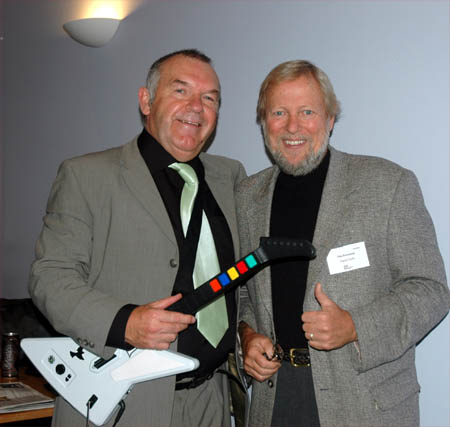
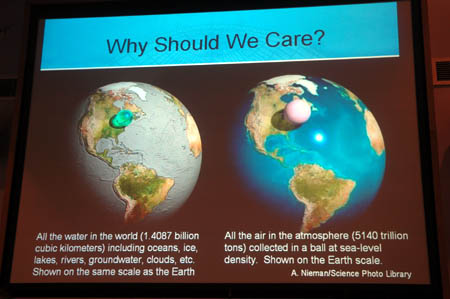
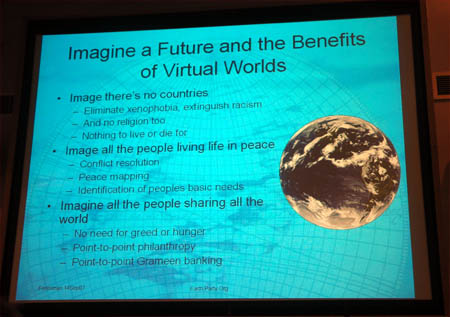
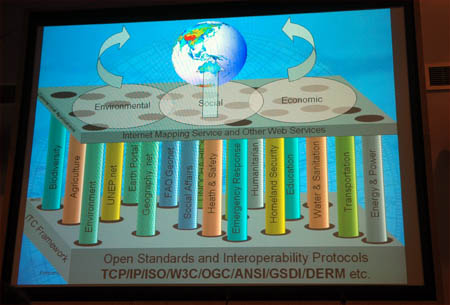
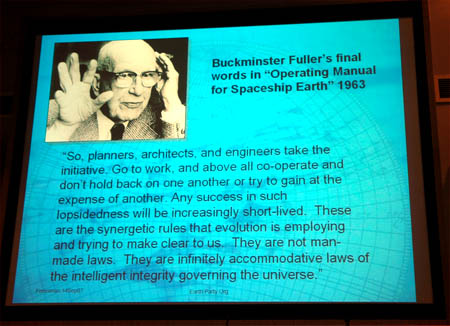
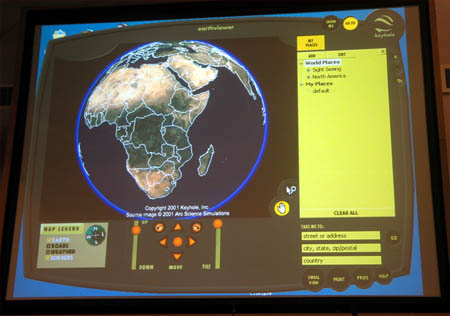
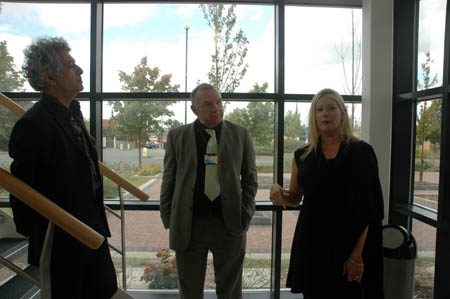
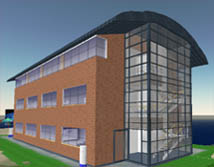
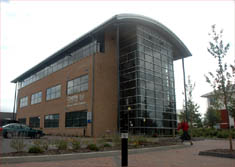
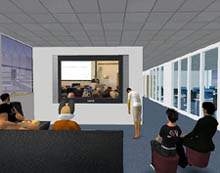
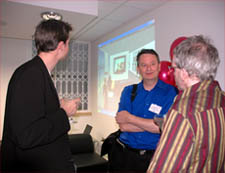
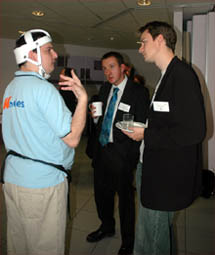
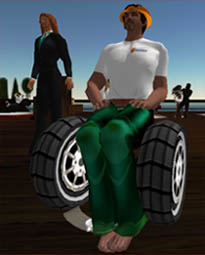
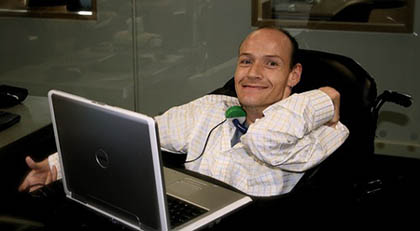
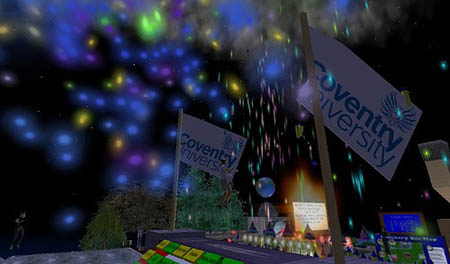

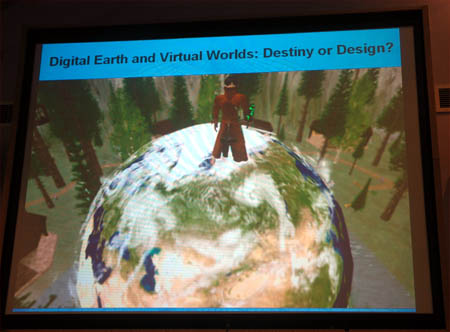
September 22nd, 2007 at 2:20 pm
http://seriousgames.ning.com
http://seriousgamesblog.blogspot.com/